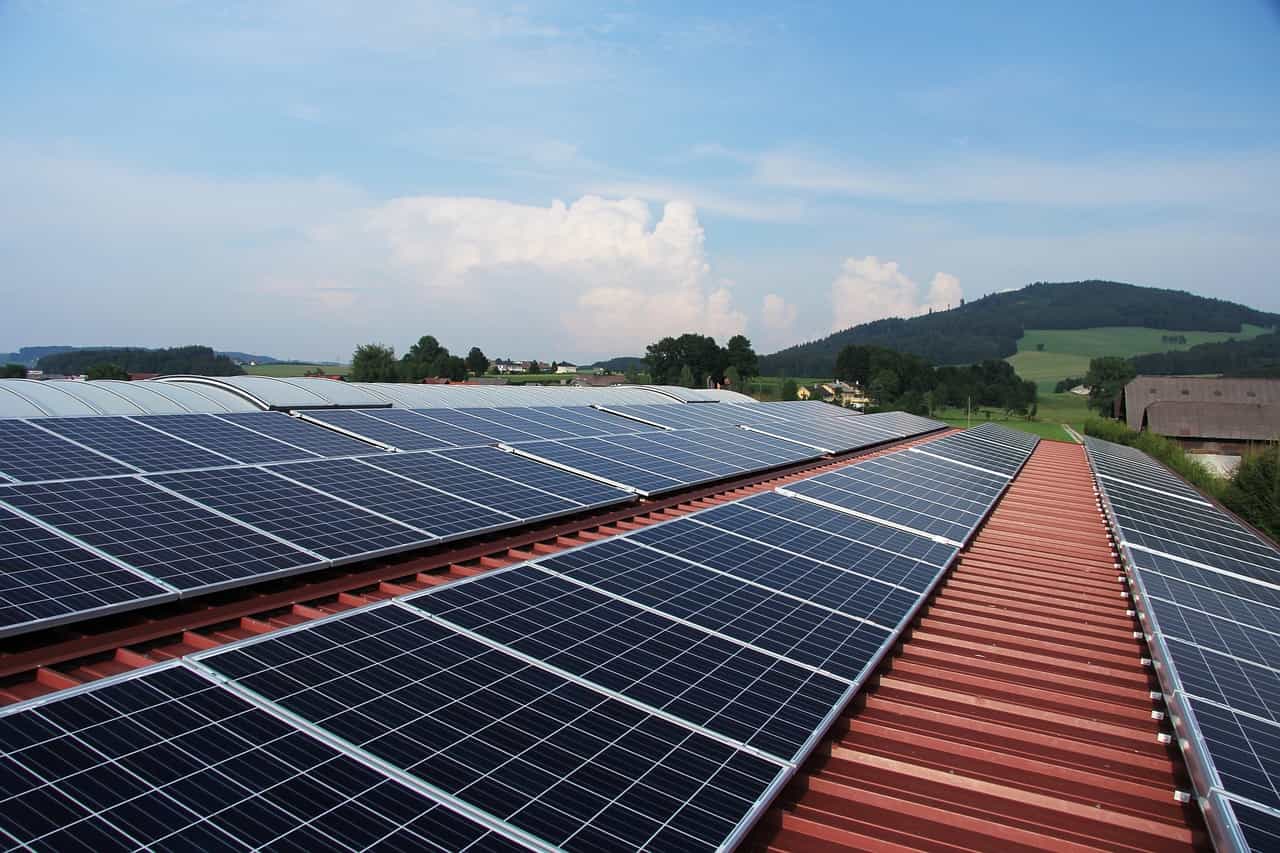Harnessing the sun’s power has long been a dream of humanity, and now, thanks to solar energy, that dream is becoming a reality. Solar power is revolutionizing how we generate electricity, providing a clean and sustainable alternative to traditional fossil fuels.
But what exactly is solar energy? In this blog post, we will explore the rise of solar power and delve into its many benefits for both the environment and our wallets.
Get ready to be amazed by how renewable energy transforms the world around us! So please sit back, relax, and dive into this illuminating topic together.
What is Solar Energy?
Solar energy converts sunlight into usable electricity, solar power, or photovoltaic (PV) energy. It involves the installation of solar panels on rooftops or in open spaces to capture sunlight and convert it into direct current (DC) electricity. This DC electricity is restored into alternating current (AC) electricity using an inverter, making it suitable for powering homes, businesses, and cities.
One of the critical components of solar energy is the solar panel itself. These panels comprise multiple individual cells called photovoltaic cells containing semiconductors like silicon. When sunlight hits these cells, photons from the sun’s rays knock electrons loose from their atoms, generating an electric current.
But how exactly does this magic happen? Each photovoltaic cell contains a positive and negative layer, creating an electric field.
Solar energy systems can be connected to electrical grids or used independently as off-grid systems with battery storage. The surplus electricity generated by these systems can be fed back into the grid for others to use or stored for later consumption when there isn’t enough sunlight available.
Technological advancements have made solar panels more efficient and affordable than ever in recent years. With increased awareness about climate change and environmental sustainability efforts gaining traction worldwide, more individuals and organizations are turning to solar energy as a viable solution for clean power generation.
The Rise of Solar Power
Solar power has experienced a remarkable rise in popularity and adoption over the past decade. As concerns about climate change and the need for sustainable energy sources have grown, solar power has emerged as a leading solution.
One of the key factors driving this rise is the increasing efficiency and affordability of solar technology. Advances in photovoltaic cells have led to excellent conversion rates, meaning that more sunlight can be converted into usable electricity. Additionally, declining solar panels and installation costs have made it more accessible to homeowners, businesses, and governments.
Another driver behind the rise of solar power is the growing recognition of its environmental benefits. Solar energy produces no greenhouse gas emissions during operation, making it a clean alternative to fossil fuels. This means solar power helps reduce air pollution and combat climate change.
Moreover, laws and incentives are being implemented by governments throughout the globe to encourage the use of renewable energy. Participating in community-based projects such as Solarize programs or installing solar panels may earn you tax credits or refunds in several countries.
In addition to these factors, public awareness and support for renewable energy have contributed to the rise of solar power. People are increasingly educated about the environmental impacts of traditional energy sources like coal or oil, leading them to seek cleaner alternatives.
We will likely have even more technological advancements and cost reductions as we continue this upward trajectory toward increased reliance on solar power. The future holds great promise for further expanding our use of renewable energy sources such as solar power.
Benefits of Solarize Energy
Solarize Energy offers numerous benefits that make it a game-changer in renewable power. One of the most significant advantages is its positive impact on the environment. By harnessing energy from sunlight, solar power helps reduce greenhouse gas emissions and combat climate change. Unlike traditional fossil fuels, solar energy production does not release harmful pollutants into the atmosphere, making it a clean and sustainable alternative.
Another significant benefit of Solarize Energy is its potential for cost savings. Installing solar panels allows homeowners to generate electricity, reducing their reliance on utility companies and lowering their monthly bills. Additionally, many governments offer financial incentives such as tax credits or rebates to encourage individuals and businesses to adopt solar power systems.
The growth of Solarize Energy has also led to job creation and economic development. As more people embrace this technology, a growing demand for skilled workers in installation, maintenance, manufacturing, and research sectors related to solar power is growing. This boosts local economies in addition to creating job possibilities.
Furthermore, solar power has a global impact by providing access to affordable and clean electricity in remote areas where grid connectivity may be challenging or nonexistent. It improves living conditions by powering reliable sources for schools, hospitals, homes, and businesses.
Looking towards the future outlook of Solarize power shows immense potential for continued growth and innovation in renewable power technologies. Advancements in battery storage systems enable better utilization of excess solar energy generated during daylight hours when demand may be lower.
Environmental Impact
The ecology dramatically benefits from the use of solar electricity. By harnessing the sun’s power, this renewable power source reduces our dependence on fossil fuels and decreases greenhouse gas emissions. Unlike traditional forms of electricity generation, solar power does not release harmful pollutants into the air or water.
One of the leading environmental benefits of astronomy power is its ability to mitigate climate change. Reducing carbon dioxide emissions helps combat global warming and air pollution, improving air quality and public health. Astronomy power also conserves water resources since it requires little to no water compared to coal or natural gas plants.
Furthermore, astronomy panels can be installed on various types of land without causing significant disruption to ecosystems. This enables us to utilize spaces that may otherwise be unused or unproductive while preserving valuable habitats for wildlife.
The growth of astronomy power also contributes to reducing reliance on non-renewable resources such as coal, oil, and natural gas. As these finite resources become scarcer and more expensive, transitioning towards sustainable sources like astronomy power becomes increasingly important for long-term sustainability.
Investing in astronomy power offers numerous environmental advantages that help protect our planet for future generations. It’s a clean, renewable solution that minimizes ecological harm while providing reliable electricity generation.
Cost Savings and Financial Incentives
One of the most enticing benefits of solar energy is the potential for significant cost savings. By harnessing the power of sunlight, individuals and businesses can offset their reliance on traditional grid electricity, which often comes with high bills and fluctuating rates. Astronomy panels allow you to generate clean, renewable power at home or your business place.
Installing astronomy panels may require an initial investment but can lead to substantial long-term savings. Astronomy power can reduce or even eliminate your monthly electricity bill by generating power. Additionally, some utility companies offer net metering programs that allow homeowners to sell excess electricity back to the grid, further reducing costs.
Financial incentives also play a crucial role in making astronomy power accessible and affordable for everyone. Many governments and local authorities provide tax credits or rebates for installing astronomy panels. These incentives help offset the upfront installation costs and make it easier for individuals to transition to renewable power sources.
Furthermore, some states have implemented feed-in tariffs (FITs) that guarantee a fixed rate for selling excess electricity from astronomy panels back into the grid. This provides additional income opportunities for homeowners while promoting sustainable power generation.
In addition to these financial benefits, choosing astronomy power protects against future utility prices. As non-renewable resources become scarcer and more expensive, relying on clean power sources like sunlight becomes increasingly advantageous financially.
By taking advantage of cost savings through reduced electric bills, government incentives such as tax credits or FITs, and protection against rising utility prices, transitioning to astronomy power offers immediate and long-term financial advantages.
Jobs and Economic Growth
Solar power has brought about significant environmental benefits and has profoundly impacted job creation and economic growth. As the demand for renewable energy continues to rise, so does the need for skilled professionals in various industry sectors.
One area that has experienced substantial growth is the installation and maintenance of astronomy panels. With more people opting for solar energy systems, there is a growing demand for technicians who can install and service these systems. This provides ample employment opportunities for individuals looking to enter or transition into this field.
Moreover, the manufacturing sector associated with astronomy power has seen considerable expansion. Astronomy panel production requires specialized equipment and skilled workers to assemble the components. This generates jobs in manufacturing plants, contributing to local economies.
Additionally, as more businesses realize the financial benefits of transitioning to renewable energy sources like astronomy power, they invest in integrating such technologies into their operations. This shift creates new positions across industries as companies hire experts in sustainable energy management and system integration.
Furthermore, governments worldwide recognize that investing in renewable energy can stimulate economic development by attracting investments from both domestic and international markets. By incentivizing companies to invest in clean technologies like astronomy power, governments create an environment conducive to innovation and job creation.
Global Impact and Future Outlook
The global impact of solar energy is undeniable. As more countries and communities embrace renewable power, we see a significant shift towards a sustainable future. Astronomy power has the potential to revolutionize our energy systems and reduce our dependence on fossil fuels.
One of the critical benefits of astronomy energy is its ability to combat climate change. We can significantly reduce greenhouse gas emissions contributing to global warming by harnessing the sun’s power. This not only helps mitigate the impacts of climate change but also preserves our planet for future generations.
Moreover, solar energy offers a reliable source of electricity in areas where traditional grid infrastructure may be limited or unreliable. This makes it particularly advantageous for developing countries, providing access to clean and affordable energy solutions.
In terms of future outlook, the growth potential for astronomy energy is immense. Technological advancements continue to drive down costs and improve efficiency, making astronomy power increasingly accessible across various sectors. As economies scale their renewable capacity, we can expect job creation and economic growth in solar installation, manufacturing, research, and development industries.
Additionally, with ongoing innovation in storage technologies such as batteries, astronomy power will become even more versatile by enabling round-the-clock usage without reliance on sunlight alone.
As governments worldwide set ambitious targets for renewable energy deployment through policies and incentives, it becomes evident that astronomy energy will play an integral role in transforming our global energy landscape.
How to Get Involved in Solarize Energy
1. Educate Yourself: Start by learning about the benefits and processes of astronomy energy: research local incentives, regulations, and available technologies. Gaining knowledge of the fundamentals will enable you to make wise choices.
2. Calculate Your Energy Needs: To determine your required astronomy power, assess your current energy usage. Consider roof size, location, and climate conditions affecting astronomy panel installation.
3. Locate a Trustworthy Installer: Look for qualified astronomy installers with expertise in planning and installing systems that meet your requirements. Get estimates from several businesses so you may compare costs and services.
4. Explore Financing Options: Investigate financing options like loans or leasing programs that can help make the upfront costs more affordable. Some areas offer rebates or tax credits for purchasing solar systems.
5. Connect with Local Communities: Join local sustainable energy organizations or attend workshops focused on renewable energy initiatives in your area. Interact with people who share your enthusiasm for changing the world.
6. Advocate for Policy Changes: Support policies that promote renewable energy adoption at local and national levels by contacting elected officials, attending public hearings, or participating in grassroots campaigns.
7. Celebrate Your Successes: Share your journey towards embracing Astronomypower through social media platforms or organizing community events to inspire others within your network.
Conclusion
Solar energy is rapidly transforming the world, and its benefits are undeniable. By harnessing the power of sunlight, we can reduce our reliance on fossil fuels and combat climate change. The rise of solar power has not only had a positive environmental impact but has also led to cost savings for individuals and businesses.
With financial incentives such as tax credits and net metering, going solar is becoming more affordable. Not only do homeowners save money on their energy bills, but they also contribute to job creation in the renewable energy sector. Solar installations require skilled workers, leading to economic growth within local communities.
On a global scale, solar power has the potential to revolutionize access to electricity in developing countries. Remote areas that were once off-grid can now benefit from clean and reliable energy sources. This shift towards sustainable solutions will improve quality of life and create new opportunities for innovation.
Getting involved in Solarize Energy is easier. Start by researching local solar providers or community initiatives that promote renewable energy adoption. Educate yourself about available incentives and financing options while considering your energy needs.
FAQS
1. What is solar energy?
Solar energy is harnessing solar power by installing and using solar panels or photovoltaic systems. It involves converting sunlight into usable electricity, providing a clean and renewable energy source.
2. How does solar power work?
Solar power captures the sun’s rays using photovoltaic cells made of semiconductor materials like silicon. When sunlight hits these cells, it excites electrons, creating an electric current that can be harnessed for various purposes.
3. What are the benefits of solar energy?
Solarize energy offers numerous benefits:
– Environmental Impact: Solar power reduces greenhouse gas emissions and dependence on fossil fuels, helping combat climate change.
– Cost Savings: By generating your electricity from solar panels, you can significantly reduce or eliminate your monthly utility bills.
– Financial Incentives: Many governments offer tax credits, incentives, and rebates to encourage the adoption of solar power.
– Job Creation: The growing demand for renewable energy has created thousands of jobs in the solar industry.
– Global Impact: Solar power is crucial in transitioning towards a sustainable future and reducing our carbon footprint.
4. Is solar power reliable?
Yes! Solar Power is increasingly becoming more reliable with advancements in technology. Even on cloudy days or during winter months when there is less direct sunlight available, modern-day PV systems can still generate significant amounts of electricity.
5. Are there any limitations to using solar energy?
While there are some limitations associated with using solar power, they are manageable:
– Initial Costs: The upfront investment required for installing a residential or commercial system can be high; however, long-term cost savings offset this expense over time.
– Space Requirements: For larger installations, sufficient rooftop space or land area may be needed.
– Intermittent Generation: Electricity generation relies on sunlight availability; therefore, solar power is not constant throughout the day or night.










